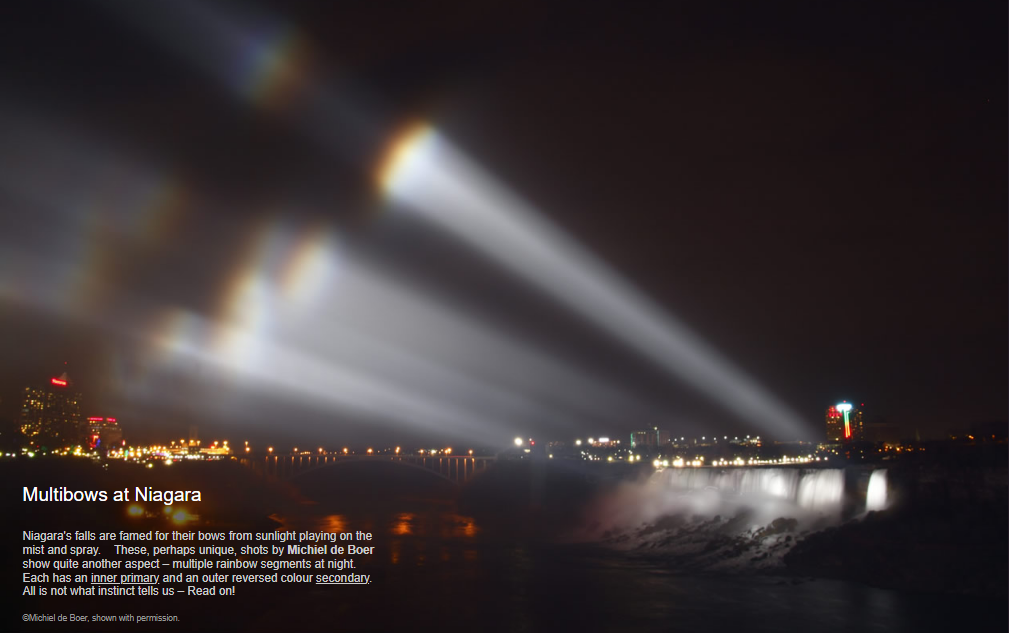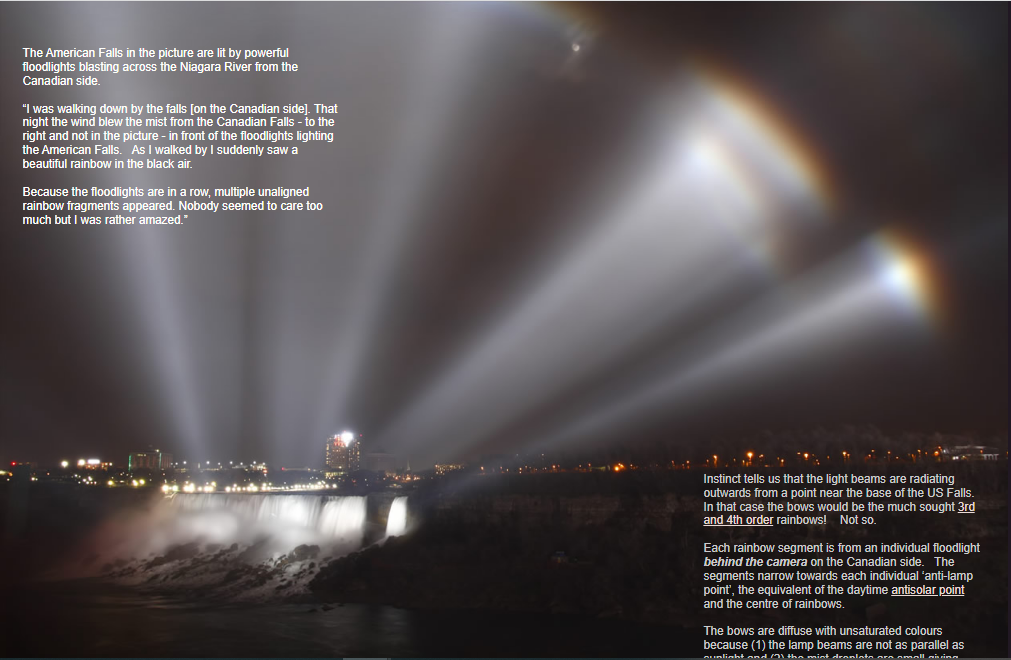OPOD - Multibows, Niagara
OPOD - Multibows, Niagara: A Dazzling Display of Rainbow Segments
When we think of Niagara Falls, we often imagine the majestic bows created by sunlight dancing on the mist and spray. However, there is another captivating phenomenon that occurs at this natural wonder - the appearance of multiple rainbow segments at night. These incredible shots, captured by photographer Michiel de Boer, reveal a unique and lesser-known aspect of Niagara's beauty. Each multibow consists of an inner primary rainbow and an outer reversed color secondary rainbow. In this article, we will delve into the fascinating details of these multibows and explore the science behind their formation.
As de Boer wandered near the falls on the Canadian side one night, he noticed a peculiar sight. The powerful floodlights illuminating the American Falls projected their beams across the Niagara River, while the wind blew mist from the Canadian Falls in front of the floodlights. In this unusual combination of light and mist, de Boer witnessed a breathtaking rainbow suspended in the dark sky. While others may have overlooked this phenomenon, de Boer was amazed by the sight before him.
At first glance, one might assume that the light beams originate from a single point near the base of the American Falls, resulting in the much sought-after 3rd and 4th order rainbows. However, this instinctual interpretation is incorrect. Each segment of the multibow actually originates from an individual floodlight positioned behind the camera on the Canadian side. The narrowness of each segment is due to its proximity to the corresponding "anti-lamp point," which serves as the center of each rainbow segment, similar to the daytime antisolar point.
The appearance of these multibows is different from traditional rainbows. They exhibit a diffuse quality with unsaturated colors for two main reasons. Firstly, the lamp beams are not as parallel as sunlight, causing the diffused light to scatter in various directions. Secondly, the mist droplets in the air are relatively small, leading to the formation of fogbows. These factors contribute to the unique and captivating aesthetic of the multibows at Niagara Falls.
It is worth noting that the floodlights used to create these multibows are directed towards the Canadian Falls, while the ones responsible for the photographed bows can be faintly seen in the background, aimed at the American Falls. However, this phenomenon is not limited to floodlights alone. Smaller lamps and even car headlights (when not in use for driving) can also generate remarkable ice halos, fogbows, and glories under suitable atmospheric conditions.
The multibows at Niagara Falls serve as a reminder of the intricacies and beauty of atmospheric optics. They demonstrate how light, mist, and the arrangement of light sources can come together to create a mesmerizing visual spectacle. These multibows may not be as well-known as their daytime counterparts, but they are a testament to the wonders that can be found in the natural world, even under the cover of darkness.
In conclusion, Michiel de Boer's stunning photographs of multibows at Niagara Falls offer a fresh perspective on this iconic natural wonder. The presence of multiple rainbow segments at night, formed by individual floodlights and mist droplets, creates a magical display that captivates the imagination. By understanding the science behind these multibows, we gain a deeper appreciation for the complexities of atmospheric optics and the enchanting phenomena they produce.

Multibows at Niagara
Niagara's falls are famed for their bows from sunlight playing on the mist and spray. These, perhaps unique, shots by Michiel de Boer show quite another aspect – multiple rainbow segments at night. Each has an inner primary and an outer reversed colour secondary. All is not what instinct tells us – Read on!
©Michiel de Boer, shown with permission.

The American Falls in the picture are lit by powerful floodlights blasting across the Niagara River from the Canadian side.
“I was walking down by the falls .on the Canadian side.. That night the wind blew the mist from the Canadian Falls - to the right and not in the picture - in front of the floodlights lighting the American Falls. As I walked by I suddenly saw a beautiful rainbow in the black air.
Because the floodlights are in a row, multiple unaligned rainbow fragments appeared. Nobody seemed to care too much but I was rather amazed.”
Instinct tells us that the light beams are radiating outwards from a point near the base of the US Falls. In that case the bows would be the much sought 3rd and 4th order rainbows! Not so.
Each rainbow segment is from an individual floodlight behind the camera on the Canadian side. The segments narrow towards each individual ‘anti-lamp point’, the equivalent of the daytime antisolar point and the centre of rainbows.
The bows are diffuse with unsaturated colours because (1) the lamp beams are not as parallel as sunlight and (2) the mist droplets are small giving tendencies towards fogbows.

The floodlights. These ones beam towards the Canadian Falls, the ones directed at the US Falls that created the pictured bows can be seen faintly in the background.
Smaller lamps, and car headlamps (not when driving!), can be used to generate outstanding ice halos, fogbows and glories.
Note: this article has been automatically converted from the old site and may not appear as intended. You can find the original article here.
Reference Atmospheric Optics
If you use any of the definitions, information, or data presented on Atmospheric Optics, please copy the link or reference below to properly credit us as the reference source. Thank you!
-
<a href="https://atoptics.co.uk/blog/opod-multibows-niagara/">OPOD - Multibows, Niagara</a>
-
"OPOD - Multibows, Niagara". Atmospheric Optics. Accessed on November 25, 2024. https://atoptics.co.uk/blog/opod-multibows-niagara/.
-
"OPOD - Multibows, Niagara". Atmospheric Optics, https://atoptics.co.uk/blog/opod-multibows-niagara/. Accessed 25 November, 2024
-
OPOD - Multibows, Niagara. Atmospheric Optics. Retrieved from https://atoptics.co.uk/blog/opod-multibows-niagara/.